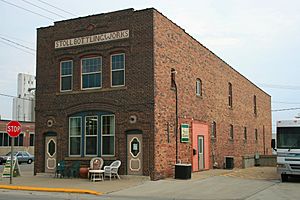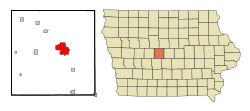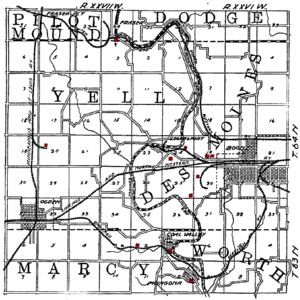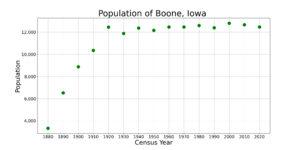Boone, Iowa facts for kids
Quick facts for kids
Boone
|
|
|---|---|

Stoll Bottling Works Building in Boone
|
|

Location of Boone, Iowa
|
|
| Country | United States |
| State | Iowa |
| County | Boone |
| Township | Des Moines |
| Incorporated | 1849 |
| Area | |
| • Total | 9.08 sq mi (23.53 km2) |
| • Land | 9.08 sq mi (23.53 km2) |
| • Water | 0.00 sq mi (0.00 km2) |
| Elevation | 1,135 ft (346 m) |
| Population
(2020)
|
|
| • Total | 12,460 |
| • Density | 1,371.64/sq mi (529.57/km2) |
| Time zone | UTC-6 (Central (CST)) |
| • Summer (DST) | UTC-5 (CDT) |
| ZIP codes |
50036-50037
|
| Area code(s) | 515 |
| FIPS code | 19-07480 |
| GNIS feature ID | 0454753 |
| Website | www.boonegov.com |
Boone (/ˈbuːn/ BOON) is a city in Iowa, United States. It is the main city and county seat of Boone County, Iowa.
In 2020, about 12,460 people lived in Boone. It is the most important city in the Boone, Iowa Micropolitan Statistical Area. This area includes all of Boone County.
Contents
History of Boone
Coal mining was very important to Boone's early days. As early as 1849, local blacksmiths were digging coal from Honey Creek. This was south of where Boone is today.
The town of Boone was planned in 1865 by John Insley Blair. It became an official city in 1866. This happened when the Chicago and North Western Transportation Company built a train station there. The town was first called "Montana." It was renamed Boone in 1871. The name honors Nathan Boone, who was the son of the famous explorer Daniel Boone.
The arrival of the railroad helped coal mining grow. In 1867, Canfield and Taylor opened a mine near town. Their mine shaft was 242 feet deep. They used wagons to carry coal to the railroad. In 1874, a special train track was built to the mine. The railroad later took over this mine and ran it for 30 years.
Boone had different types of coal. The top layer, about 3 feet thick, was always mined using a method called longwall mining. The lower layer was mined using room and pillar mining. In 1912, a local coal miners' union had 554 members. This was almost 10% of the city's population back then.
Many well-known businesses started or have offices in Boone. The grocery store chain Fareway began here and still has its main offices in town.
The very first Casey's General Store opened in Boone in 1968. Other large companies have also had facilities in Boone. These include Gates Rubber, Archway Bakery, and Coca-Cola Bottling.
Geography of Boone
Boone covers an area of about 9 square miles (23.5 square kilometers). All of this area is land.
Ledges State Park is a popular place to visit. It is located just four miles south of Boone.
Climate in Boone
Boone has a hot-summer humid continental climate. This means it has warm, humid summers and cold winters.
| Climate data for Boone, Iowa, 1991–2020 normals, extremes 1904–present | |||||||||||||
|---|---|---|---|---|---|---|---|---|---|---|---|---|---|
| Month | Jan | Feb | Mar | Apr | May | Jun | Jul | Aug | Sep | Oct | Nov | Dec | Year |
| Record high °F (°C) | 68 (20) |
77 (25) |
88 (31) |
95 (35) |
110 (43) |
106 (41) |
111 (44) |
111 (44) |
103 (39) |
95 (35) |
82 (28) |
72 (22) |
111 (44) |
| Mean maximum °F (°C) | 50.8 (10.4) |
55.6 (13.1) |
72.0 (22.2) |
82.8 (28.2) |
88.6 (31.4) |
92.4 (33.6) |
94.2 (34.6) |
92.8 (33.8) |
90.1 (32.3) |
84.0 (28.9) |
69.1 (20.6) |
54.9 (12.7) |
95.9 (35.5) |
| Mean daily maximum °F (°C) | 28.2 (−2.1) |
33.3 (0.7) |
46.3 (7.9) |
60.0 (15.6) |
71.0 (21.7) |
80.7 (27.1) |
84.2 (29.0) |
82.2 (27.9) |
76.1 (24.5) |
63.2 (17.3) |
46.9 (8.3) |
33.8 (1.0) |
58.8 (14.9) |
| Daily mean °F (°C) | 18.7 (−7.4) |
23.3 (−4.8) |
35.9 (2.2) |
48.4 (9.1) |
59.7 (15.4) |
69.6 (20.9) |
73.5 (23.1) |
71.5 (21.9) |
63.9 (17.7) |
51.0 (10.6) |
36.8 (2.7) |
24.8 (−4.0) |
48.1 (9.0) |
| Mean daily minimum °F (°C) | 9.1 (−12.7) |
13.3 (−10.4) |
25.6 (−3.6) |
36.7 (2.6) |
48.5 (9.2) |
58.6 (14.8) |
62.7 (17.1) |
60.8 (16.0) |
51.7 (10.9) |
38.8 (3.8) |
26.8 (−2.9) |
15.8 (−9.0) |
37.4 (3.0) |
| Mean minimum °F (°C) | −13.7 (−25.4) |
−8.5 (−22.5) |
4.1 (−15.5) |
21.2 (−6.0) |
33.4 (0.8) |
45.0 (7.2) |
51.8 (11.0) |
50.7 (10.4) |
36.4 (2.4) |
23.6 (−4.7) |
9.9 (−12.3) |
−5.2 (−20.7) |
−17.6 (−27.6) |
| Record low °F (°C) | −35 (−37) |
−35 (−37) |
−22 (−30) |
−1 (−18) |
21 (−6) |
35 (2) |
40 (4) |
35 (2) |
23 (−5) |
−6 (−21) |
−11 (−24) |
−25 (−32) |
−35 (−37) |
| Average precipitation inches (mm) | 1.20 (30) |
1.41 (36) |
2.26 (57) |
4.06 (103) |
5.17 (131) |
5.38 (137) |
4.80 (122) |
4.92 (125) |
3.32 (84) |
2.97 (75) |
2.08 (53) |
1.57 (40) |
39.14 (993) |
| Average snowfall inches (cm) | 9.9 (25) |
9.3 (24) |
5.0 (13) |
1.3 (3.3) |
0.0 (0.0) |
0.0 (0.0) |
0.0 (0.0) |
0.0 (0.0) |
0.0 (0.0) |
0.6 (1.5) |
1.9 (4.8) |
7.9 (20) |
35.9 (91.6) |
| Average precipitation days (≥ 0.01 in) | 8.9 | 8.5 | 9.5 | 12.5 | 14.4 | 12.8 | 10.4 | 10.9 | 9.2 | 9.4 | 7.7 | 8.8 | 123 |
| Average snowy days (≥ 0.1 in) | 6.1 | 5.8 | 2.8 | 1.0 | 0.0 | 0.0 | 0.0 | 0.0 | 0.0 | 0.3 | 1.4 | 5.2 | 22.6 |
| Source 1: NOAA | |||||||||||||
| Source 2: National Weather Service | |||||||||||||
People in Boone
| Historical population | |||
|---|---|---|---|
| Census | Pop. | %± | |
| 1880 | 3,330 | — | |
| 1890 | 6,520 | 95.8% | |
| 1900 | 8,880 | 36.2% | |
| 1910 | 10,347 | 16.5% | |
| 1920 | 12,451 | 20.3% | |
| 1930 | 11,886 | −4.5% | |
| 1940 | 12,373 | 4.1% | |
| 1950 | 12,164 | −1.7% | |
| 1960 | 12,468 | 2.5% | |
| 1970 | 12,468 | 0.0% | |
| 1980 | 12,602 | 1.1% | |
| 1990 | 12,392 | −1.7% | |
| 2000 | 12,803 | 3.3% | |
| 2010 | 12,661 | −1.1% | |
| 2020 | 12,460 | −1.6% | |
| U.S. Decennial Census | |||
2020 Census Information
In 2020, Boone had 12,460 people living in 5,410 households. About 27% of these households had children under 18. Most residents (92.8%) were White. About 1.2% were Black, and 0.6% were Asian. People of Hispanic or Latino background made up 2.6% of the population.
The average age in Boone was 41.2 years. About 24% of residents were under 20 years old. About 20% were 65 years or older. The city had slightly more females (51.4%) than males (48.6%).
Getting Around Boone
Boone is located on U.S. Route 30. This major highway helps people travel in and out of the city.
Boone is also served by the Union Pacific Railroad. This railroad bought the Chicago & North Western Railroad in 1995. Boone was an important stop for trains and crews. There is still a train yard east of downtown.
An old electric train line, the Fort Dodge, Des Moines & Southern Railroad, used to run through Boone. It was later changed to use diesel engines. Part of this old line is now the Boone and Scenic Valley Railroad. This is a fun train ride for tourists.
Boone's Economy
Boone has a good job market. The unemployment rate is 2.8%, which is lower than the national average. Experts predict job growth will be about 33.14% in the future.
The average income per person in Boone is $23,283. The average household income is $46,749.
Education in Boone
The Boone Community School District runs the public schools in the city. There are also private schools. Sacred Heart parish has a school for kindergarten through 8th grade. Trinity Lutheran Church also has a school for young children up to 8th grade.
Des Moines Area Community College (DMACC) has a campus in Boone. It was opened in 1969.
Fun Things to Do in Boone
Festivals and Events
- Pufferbilly Days: This is an annual festival that celebrates Boone's railroad history. It happens at the end of summer. Over 30,000 people attend, making it one of Iowa's biggest community festivals.
- IMCA Super Nationals: This racing event takes place at the Boone Speedway. It happens during the week of Labor Day.
- Boone River Valley Festival: Started in 2017, this outdoor festival is in May. It celebrates the beauty and activities of Boone and Boone County.
- Farm Progress Show: Boone is one of two permanent locations for this large agricultural show. It happens every other year, showing off the latest in farming.
Tourist Attractions
- Theodore Roosevelt Statue: This large statue of former President Theodore Roosevelt is in McHose Park. It was made by Vincenzo Miserendino. The statue shows Roosevelt reaching out, as if talking to a crowd.
- Boone & Scenic Valley Railroad & James H. Andrew Railroad Museum: You can ride historic trains through Boone and the Boone River Valley. They have special events like "Day Out with Thomas" (Thomas the Tank Engine) and dinner trains. The museum shows off railroad history with many exhibits.
Parks and Recreation
J.B. McHose Park and Shelter is the biggest park in Boone. It has many things to do, including:
- Shelters for picnics
- Baseball fields and tennis courts
- A sand volleyball area and a basketball court
- Playgrounds for kids
- Nature trails and an equestrian trail
- A fishing pond
- The famous Teddy Roosevelt monument
- A bike trail and a disc golf course
- A swimming pool
Famous People from Boone
- Mamie Geneva Doud: She was born in Boone. She became the First Lady of the United States, married to President Dwight D. Eisenhower. A main street in Boone is named after her.
- Norman Arthur Erbe: He was a Republican Governor of Iowa from 1961 to 1963. He was born and lived in Boone.
- Jerry McNertney: An MLB (Major League Baseball) player for teams like the Seattle Pilots/Milwaukee Brewers.
- Hap Moran: An All-American basketball player from Boone High School and a football star for the New York Giants.
- Chad Rinehart: An offensive lineman for the San Diego Chargers and an All-American for the University of Northern Iowa.
- Darlene Rose: A missionary who survived being held in a Japanese War Camp during World War II.
- Ed Updegraff: A famous golfer who won the U.S. Senior Amateur and Walker Cup. He was also a doctor.
- Curtis D. Wilbur: A lawyer, judge, and the 43rd United States Secretary of the Navy.
- Ray Lyman Wilbur: The third president of Stanford University and also the United States Secretary of the Interior. He was born in Boone.
See also
 In Spanish: Boone (Iowa) para niños
In Spanish: Boone (Iowa) para niños




